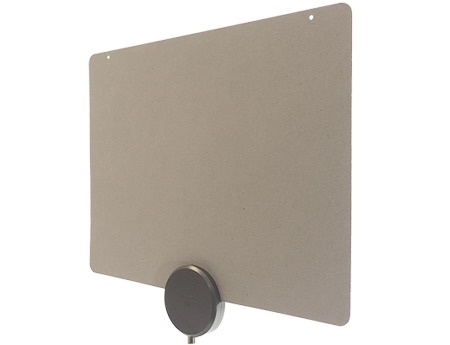New HDTV Antennas Made From Recycled Set-Tops

Irony thy name is Mohu.
The Raleigh, N.C.-based TV antenna maker’s latest HDTV antenna offering is made out of recycled materials, and for the plastic, the company turned to the reason people might be buying an HDTV antenna in the first place: discarded cable set-top boxes.
“With [tens of millions of] homes in the U.S. subscribing to cable TV and the number of cord cutters consistently rising, the number of set-top boxes that will eventually be discarded are in the millions,” Mark Buff, CEO of Mohu, said in a statement. “We realized we could decrease some of that waste by repurposing plastic byproduct from discarded cable set-top boxes to create a TV antenna that frees consumers from excessive cable waste.”
Dubbed ReLeaf, the HDTV antenna (priced at $49.99) has a plastic clamshell — housing the device’s over-the-air digital components — made entirely from recycled plastic of cable set-tops, with Mohu sharing that one pound of recycled plastic from cable set-top boxes can be used to create 40 ReLeaf clamshells.
Continuing with the recycled theme, the flat portion of the ReLeaf’s antenna (covering the inner foil that catches over-the-air signals) is made of post-consumer recycled paper. The company even touts that its packaging is made up of 100% recycled cardboard.
Buff makes no bones about his company’s anti-cable mission, saying Mohu has saved consumers more than $300 million (“by reducing or eliminating costly monthly cable and satellite bills”) since its first HDTV antenna offering in 2011.
“ReLeaf is the answer for consumers who are anti-cable, pro-environment, and pro-savings,” Buff said. “We will continue leading the cord-cutting fight against cable giants, and plan to offer consumers even more environmentally friendly products in the future to further counteract the environmental wastefulness coming from the industry.
Broadcasting & Cable Newsletter
The smarter way to stay on top of broadcasting and cable industry. Sign up below
“Waste generated by the cable industry goes well beyond the sheer financial waste imposed on consumers. The energy and product waste from cable is a serious environmental issue and one that the consumer electronics industry must face head on, and a challenge we eagerly accept.”










